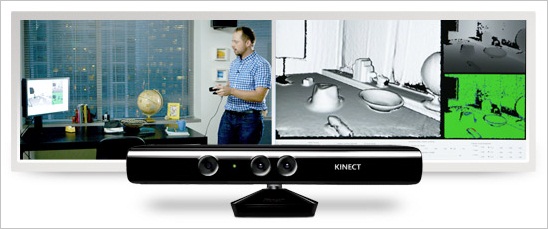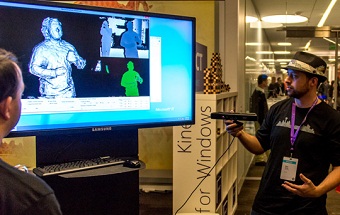Kinect Fusion Coming to Kinect for Windows
Last week, I had the privilege of giving attendees at the Microsoft event, BUILD 2012, a sneak peek at an unreleased Kinect for Windows tool: Kinect Fusion.
Kinect Fusion was first developed as a research project at the Microsoft Research lab in Cambridge, U.K. As soon as the Kinect for Windows community saw it, they began asking us to include it in our SDK. Now, I’m happy to report that the Kinect for Windows team is, indeed, working on incorporating it and will have it available in a future release.

In this Kinect Fusion demonstration, a 3-D model of a home office is being created by capturing multiple views of the room and the objects on and around the desk. This tool has many practical applications, including 3-D printing, digital design, augmented reality, and gaming.
Kinect Fusion reconstructs a 3-D model of an object or environment by combining a continuous stream of data from the Kinect for Windows sensor. It allows you to capture information about the object or environment being scanned that isn’t viewable from any one perspective. This can be accomplished either by moving the sensor around an object or environment or by moving the object being scanned in front of the sensor.
 Kinect Fusion takes the incoming depth data from the Kinect for Windows sensor and uses the sequence of frames to build a highly detailed 3-D map of objects or environments. The tool then averages the readings over hundreds or thousands of frames to achieve more detail than would be possible from just one reading. This allows Kinect Fusion to gather and incorporate data not viewable from any single view point. Among other things, it enables 3-D object model reconstruction, 3-D augmented reality, and 3-D measurements. You can imagine the multitude of business scenarios where these would be useful, including 3-D printing, industrial design, body scanning, augmented reality, and gaming.
Kinect Fusion takes the incoming depth data from the Kinect for Windows sensor and uses the sequence of frames to build a highly detailed 3-D map of objects or environments. The tool then averages the readings over hundreds or thousands of frames to achieve more detail than would be possible from just one reading. This allows Kinect Fusion to gather and incorporate data not viewable from any single view point. Among other things, it enables 3-D object model reconstruction, 3-D augmented reality, and 3-D measurements. You can imagine the multitude of business scenarios where these would be useful, including 3-D printing, industrial design, body scanning, augmented reality, and gaming.
We look forward to seeing how our developer community and business partners will use the tool.
Chris White
Senior Program Manager, Kinect for Windows
Key Links